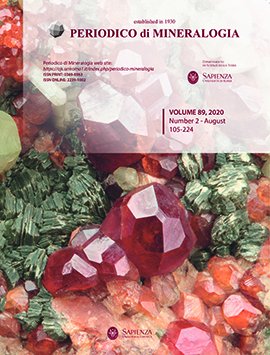Mangani-pargasite, NaCa2(Mg4Mn3+)(Si6Al2)O22(OH)2 , a new mineral species of the amphibole
Keywords:
Mangani-pargasite, amphibole, Långban, Bergslagen, SwedenAbstract
Mangani-pargasite, ideally NaCa2(Mg4Mn3+)(Si6Al2)O22(OH)2 , is a new mineral species of the calcium amphibole subgroup of the amphibole supergroup. The type specimen was found on the mine dump of the Långban Fe-Mn-(Ba-As-Pb-Sb) deposit in Värmland, Bergslagen ore province, Sweden. Crystal chemical analyses resulted in the empirical chemical formula: A(Na0.90Pb0.07K0.03)Σ1.00B(Ca1.93Mn2+0.07)Σ2.00C(Mg4.25Mn3+0.39Al0.26Fe3+0.10)Σ5.00T(Si6.35Al1.65)Σ8.00O22W(OH)2.
The mineral is biaxial positive, with a = 1.635(5), b = 1.645(5), c = 1.660(5) and the measured optic angle 2V = 85(5)°. The dispersion is weak (r > v), and the optic orientation is: Y||b; Z ^ c = 25(3)°. Mangani-pargasite is red to brownish red with weak pleochroism; X = pale reddish brown, Y = pale reddish brown and Z = pale brownish red; X ≈ Y > Z.
The unit-cell parameters are a = 9.9448(5), b = 18.0171(9), c = 5.2829(3) Å, b = 105.445(3)°, V = 912.39(9) Å3, Z = 2, space group C2/m. The ten strongest reflections in the X-ray powder diffraction pattern [d-values in Å, I, (h k l)] are: 8.420, 29, (1 1 0); 3.368, 17, (1 3 1), 3.279, 49, (2 4 0); 3.141, 100, (3 1 0); 2.817, 44, (3 3 0); 2.698, 21, (1 5 1); 2.389, 18, (3 5 0); 1.904, 29, (5 1 0); 1.650, 22, (4 6 1) and 1.448, 46, (6 6 -1).


